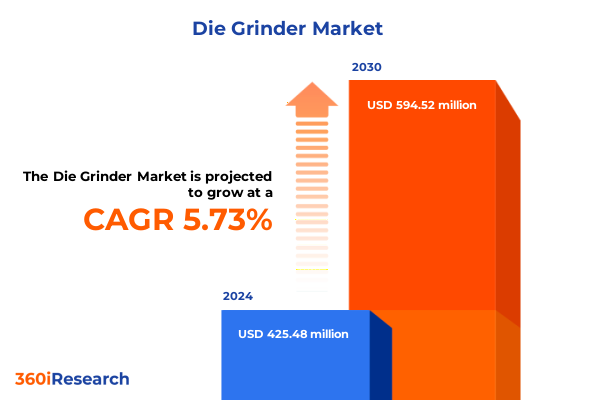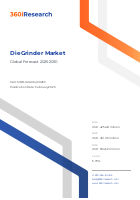The Die Grinder Market size was estimated at USD 425.48 million in 2024 and expected to reach USD 451.05 million in 2025, at a CAGR 5.73% to reach USD 594.52 million by 2030.

Introduction to the Die Grinder Market
The die grinder market stands at a pivotal juncture, shaped by rapid technological progress, evolving end-user requirements, and shifting trade dynamics. As a versatile handheld power tool, the die grinder is indispensable across fabrication, maintenance, and finishing operations in industries ranging from automotive to aerospace. Recent advancements in motor efficiency, ergonomic design, and modular attachments have elevated the die grinder from a niche specialty item to a core component of precision machining and surface preparation workflows. This introduction outlines the significance of die grinders in modern manufacturing, highlights the forces driving their widespread adoption, and sets the stage for a detailed analysis of market transformations, tariff implications, segmentation insights, and strategic imperatives for industry leaders.
Transformative Shifts in the Die Grinder Landscape
Over the past five years, the die grinder landscape has been reshaped by several transformative shifts. First, the transition from pneumatic to cordless electric die grinders has accelerated, driven by battery energy density gains and demand for greater operator mobility. As lithium-ion technology matures, cordless units rival air-powered tools in torque and speed, enabling shop floors to reduce compressor infrastructure and streamline maintenance. Second, the rise of smart tool integration has introduced digital speed control, real-time torque monitoring, and IoT connectivity. These features not only improve workplace safety but also facilitate predictive maintenance and quality assurance through data analytics.
Additionally, sustainability pressures have spurred manufacturers to use eco-friendly coatings and recyclable components, reducing the carbon footprint of both tool production and end-of-life disposal. The integration of modular attachments has further expanded the die grinder’s versatility, enabling rapid swaps between cutting, grinding, polishing, and burr-removal tasks. As manufacturers continue to invest in R&D, next-generation grinders will likely feature enhanced brushless motors, vibration-dampening systems, and adaptive speed control, cementing the die grinder’s role in precision manufacturing.
Cumulative Impact of United States Tariffs 2025
The introduction of Section 232 tariffs on select imported power tools has had a pronounced cumulative impact on the die grinder market in the United States. Since early 2025, levies on imported pneumatic and electric grinders have driven domestic suppliers to increase capacity to fill supply gaps. However, end-users have faced elevated procurement costs as importers pass tariff expenses onto customers. In response, several US-based toolmakers have accelerated localization efforts, investing in automated assembly lines and incentivizing onshore production.
Meanwhile, parallel tariffs on key components such as collets, carbides, and pneumatic fittings have disrupted global supply chains. Tool manufacturers have revisited sourcing strategies, forging alternate partnerships in Southeast Asia and Mexico to mitigate cost pressures. While short-term price inflation has impacted capital expenditure decisions, the redirection of manufacturing investment into domestic facilities is expected to strengthen resilience against future trade disruptions. Overall, the 2025 tariff measures have catalyzed a strategic realignment of production footprints, supplier relationships, and inventory management practices.
Key Segmentation Insights
Detailed segmentation analysis reveals nuanced performance across product types, applications, end-user industries, distribution channels, access modes, power sources, sizes, speed ranges, components, and accessories. For electric die grinders, corded and cordless variants exhibit divergent growth trajectories, with cordless demand surging in maintenance operations and corded models retaining strength in high-duty industrial settings. Pneumatic grinders, including right angle and straight configurations, remain preferred for heavy-duty metalworking tasks. In the realm of applications, commercial workshops and small-scale fabrication shops leverage die grinders for precision deburring and finishing, while industrial segments such as automotive assembly, shipbuilding, and large-scale manufacturing deploy robust units for high-volume production.
Examining end-user industries, the aerospace and automotive sectors prioritize vibration-reduced, high-speed models for component refinement, whereas the construction and furniture industries often select medium-speed or low-speed grinders to balance surface quality with operator comfort. From a distribution standpoint, direct sales channels cater to enterprise procurement teams seeking customized solutions, while indirect channels-spanning online platforms, traditional retailers, and wholesale distributors-address the diverse needs of contractors and small workshops. The choice between home use and professional use underscores differing performance and safety requirements, with professionals gravitating toward industrial-grade air powered and battery-operated tools. Size classifications from compact to full-size reflect deployment scenarios ranging from confined-space maintenance to large-scale operations, and high, medium, or low speed ranges accommodate task-specific requirements. Finally, component and material offerings such as carbon brushes, collets, and lubricants, alongside accessory assortments including buffers, carbide burrs, and grinding bits, further differentiate product portfolios and support targeted application outcomes.
This comprehensive research report categorizes the Die Grinder market into clearly defined segments, providing a detailed analysis of emerging trends and precise revenue forecasts to support strategic decision-making.
- Product Type
- Application
- End-User Industry
- Distribution Channel
- Access Mode
- Power Source
- Size
- Speed Range
- Component and Material
- Accessories and Attachments
Key Regional Insights
Regional dynamics in the Americas, Europe, Middle East & Africa, and Asia-Pacific each present distinct growth drivers and challenges. In the Americas, rising infrastructure spending and a resurgence of domestic manufacturing have bolstered demand for both pneumatic and electric die grinders, with Mexico emerging as a vital manufacturing hub for export to North America. Across Europe, Middle East & Africa, stringent regulatory standards on tool safety and emissions have accelerated the adoption of brushless motor technologies, while renovation projects in the Gulf and North Africa fuel requirements for portable finishing tools.
In Asia-Pacific, rapid industrialization and expansion of automotive and shipbuilding industries in China, South Korea, and Southeast Asia underpin robust growth prospects, even as local competition intensifies. Moreover, government programs promoting skill development and vocational training have increased awareness of advanced die grinder applications among small and medium-sized enterprises, driving further market penetration.
This comprehensive research report examines key regions that drive the evolution of the Die Grinder market, offering deep insights into regional trends, growth factors, and industry developments that are influencing market performance.
- Americas
- Asia-Pacific
- Europe, Middle East & Africa
Key Companies Insights
The competitive landscape is marked by a mix of global power tool conglomerates and specialized pneumatic tool manufacturers. Leading players such as 3M and Atlas Copco leverage strong R&D pipelines and extensive distribution networks to introduce advanced grinder models with integrated safety and connectivity features. Electric tool pioneers like Bosch Power Tools, DeWalt Industrial Tool Company, Makita Corporation, and Milwaukee Tool continue to push performance boundaries through brushless motor technologies, ergonomic design, and battery system interoperability.
Meanwhile, specialists such as Aircat Pneumatic Tools, Chicago Pneumatic, Dynabrade, Inc., and Fein Power Tools focus on high-precision pneumatic grinders favored in metalworking and aerospace applications. Industrial stalwarts including Ingersoll Rand, SP Air Corporation, and Atlas Copco maintain leadership in heavy-duty air-powered solutions. JET Tools, Nitto Kohki USA, Inc., PneumaticPlus, Snap-on Incorporated, Stanley Black & Decker, Inc., Sunex Tools, Hitachi Koki USA, Ltd., and Metabo round out a landscape where service, warranty programs, and accessory ecosystems play pivotal roles in securing customer loyalty.
This comprehensive research report delivers an in-depth overview of the principal market players in the Die Grinder market, evaluating their market share, strategic initiatives, and competitive positioning to illuminate the factors shaping the competitive landscape.
- 3M
- Aircat Pneumatic Tools
- Atlas Copco
- Bosch Power Tools
- Chicago Pneumatic
- DeWalt Industrial Tool Company
- Dynabrade, Inc.
- Fein Power Tools, Inc.
- Hitachi Koki USA, Ltd.
- Ingersoll Rand
- JET Tools
- Makita Corporation
- Metabo
- Milwaukee Tool
- Nitto Kohki USA, Inc.
- PneumaticPlus
- Snap-on Incorporated
- SP Air Corporation
- Stanley Black & Decker, Inc.
- Sunex Tools
Actionable Recommendations for Industry Leaders
Industry leaders must adopt a multi-pronged strategy to capitalize on evolving market conditions and fortify their competitive positions. First, continued investment in cordless electric technology and brushless motors will address mobility demands and reduce maintenance costs. Second, integrating digital features-such as real-time performance monitoring and automated speed adjustment-will differentiate offerings through enhanced productivity and safety. Third, diversifying supply chains by establishing near-shore manufacturing hubs can mitigate tariff impacts and safeguard against geopolitical risks.
Furthermore, expanding value-added services-like training programs, preventive maintenance contracts, and online troubleshooting platforms-will foster deeper customer engagement. Collaborating with vocational institutions to develop certification curricula ensures technicians are proficient with advanced die grinder functionalities, accelerating adoption. Finally, bundling modular accessories and components into tailored kits for specific applications can drive incremental revenue while simplifying procurement for end users.
Explore AI-driven insights for the Die Grinder market with ResearchAI on our online platform, providing deeper, data-backed market analysis.
Ask ResearchAI anything
World's First Innovative Al for Market Research
Conclusion and Future Outlook
The die grinder market is poised for continued evolution as technological breakthroughs, regulatory shifts, and trade realignments redefine competitive dynamics. Stakeholders who proactively embrace digital integration, flexible manufacturing footprints, and customer-centric service models will thrive in this environment. By leveraging data-driven insights and fostering innovation partnerships, toolmakers can unlock new growth avenues and deliver superior value across diverse application segments.
This section provides a structured overview of the report, outlining key chapters and topics covered for easy reference in our Die Grinder market comprehensive research report.
- Preface
- Research Methodology
- Executive Summary
- Market Overview
- Market Dynamics
- Market Insights
- Cumulative Impact of United States Tariffs 2025
- Die Grinder Market, by Product Type
- Die Grinder Market, by Application
- Die Grinder Market, by End-User Industry
- Die Grinder Market, by Distribution Channel
- Die Grinder Market, by Access Mode
- Die Grinder Market, by Power Source
- Die Grinder Market, by Size
- Die Grinder Market, by Speed Range
- Die Grinder Market, by Component and Material
- Die Grinder Market, by Accessories and Attachments
- Americas Die Grinder Market
- Asia-Pacific Die Grinder Market
- Europe, Middle East & Africa Die Grinder Market
- Competitive Landscape
- ResearchAI
- ResearchStatistics
- ResearchContacts
- ResearchArticles
- Appendix
- List of Figures [Total: 36]
- List of Tables [Total: 776 ]
Call-To-Action: Engage with Ketan Rohom for Full Report
To gain comprehensive insights into market trends, competitive strategies, and growth opportunities in the die grinder sector, contact Ketan Rohom, Associate Director of Sales & Marketing, to access the full market research report and advance your strategic decision-making.

- How big is the Die Grinder Market?
- What is the Die Grinder Market growth?
- When do I get the report?
- In what format does this report get delivered to me?
- How long has 360iResearch been around?
- What if I have a question about your reports?
- Can I share this report with my team?
- Can I use your research in my presentation?




